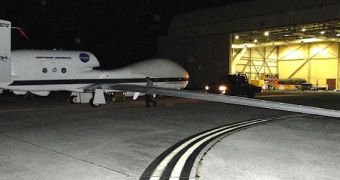An unmanned aerial system operated by the US National Aeronautics and Space Administration has just completed its first science flight as part of the Airborne Tropical Tropopause Experiment (ATTREX) mission, on Friday, February 14, 2014.
The purpose of this research effort is to use a long-range, high-autonomy UAS to study low concentration, stratospheric water vapor in Earth's atmosphere. Though spares high above the surface, the vapors are thought to play a critical role in the development of global warming and climate change.
Yesterday's science flight was conducted with the Global Hawk No. 872, which took off from the Andersen Air Force Base, on the island of Guam, in the Pacific Ocean. This drone was preferred over other because it can fly over very long distances and at high altitudes, all without a human pilot.
This was the first ATTREX science flight the NASA Global Hawk carried out this year. Its objective was to analyze cirrus clouds in the cold tropopause regions around Guam. This information will then be integrated with data already available in various climate models.

 14 DAY TRIAL //
14 DAY TRIAL //